Caesalpinia pulcherrima, commonly known as peacock flower, pride of Barbados, or peacock plant, is a stunning tropical flowering shrub. This attractive plant provides vibrant colors and interesting blooms through the summer months.
Its lush foliage and exotic appearance have made it a beloved garden plant and landscape accent from subtropical to temperate areas. Learning some key details on growing and caring for Caesalpinia pulcherrima properly will allow any gardener to include it in their outdoor spaces.
Overview of Caesalpinia pulcherrima
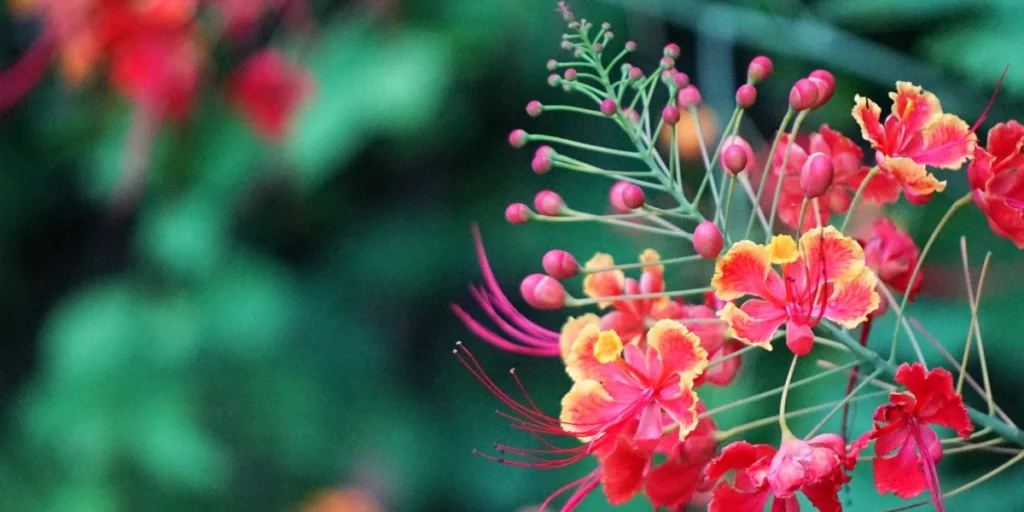
Description
Caesalpinia pulcherrima is classified as a flowering evergreen shrub that can reach a mature size of 6-10 feet tall and wide in ideal conditions. The branches on this woody shrub grow in a rigid, vase-shaped manner.
The foliage is made up of glossy compound leaves consisting of many paired leaflets on short stems. These handsome leaves offer a lush and tropical look.
Native Region and Habitat
Peacock flower shrubs originate from the tropical and subtropical regions of the Americas. They are native to areas like Mexico, Costa Rico, and the West Indies.
In the wild, Caesalpinia pulcherrima grows in dry forests and sandy coastal habitats that receive ample sunlight and humidity. They thrive as Mediterranean climates.
Flowers and Foliage
The most prized aspect of the peacock flower plant is undoubtedly its clusters of stunning blooms. They bear vibrant red and orange flowers from spring through fall that resemble the feathers of a peacock.
The colors range from solid bright yellow to deep red, with some varieties showing unique streaked combinations. Thriving plants will bloom heavily to create a spectacular floral display in the landscape.
Learn how to care Adulsa Plant here
Growing Conditions
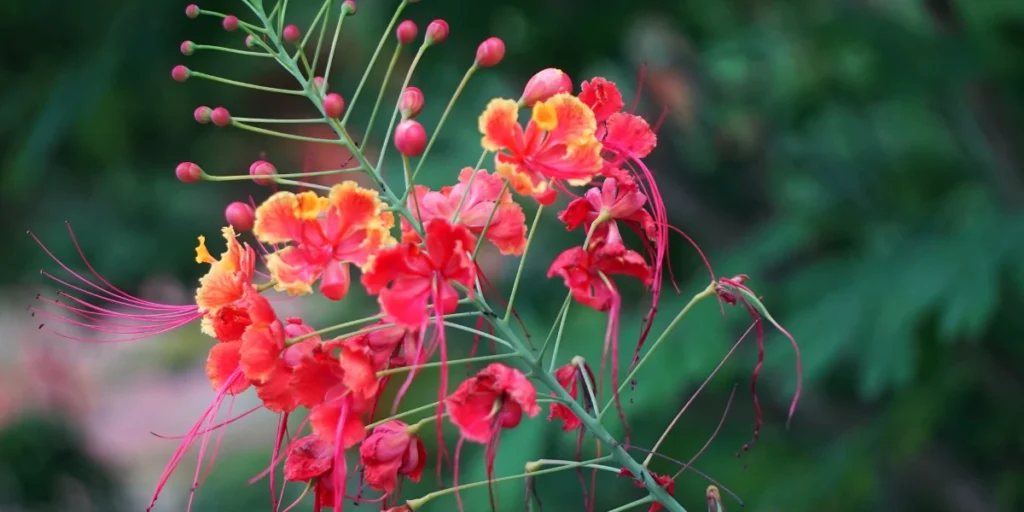
Achieving success with Caesalpinia pulcherrima relies heavily on replicating the right conditions they require.
Sun Exposure
Peacock flowers need full sun exposure for at least 6 hours per day, ideally 8-10 hours. Insufficient light will result in fewer blooms. Choose a location with maximum sunlight, especially in cooler regions.
Soil
Well-drained and nutrient-rich soil is vital. The ideal soil pH should be slightly acidic, between 5.5-7.0. Sandy loams or clay loam soils amended with compost provide good drainage and moisture retention.
Temperature and Humidity
As tropical plants, peacock flowers prefer consistent warm temperatures and humidity levels around 50-60%. Daytime temperatures of 65-85°F are suitable during the growing season for best flower production.
They can withstand short periods of heat over 100°F when properly watered. Provide supplementary watering during hot and dry spells.
Hardiness Zones
Peacock flowers tolerate winter climates in USDA Zones 9-11 as evergreen perennials when temperatures do not dip below 20°F. In Zones 8b and below, they will perish over winter outdoors unless heavily protected. Potted plants should be overwintered indoors in colder zones.
Learn how to care for Rose Apple here
How to Plant
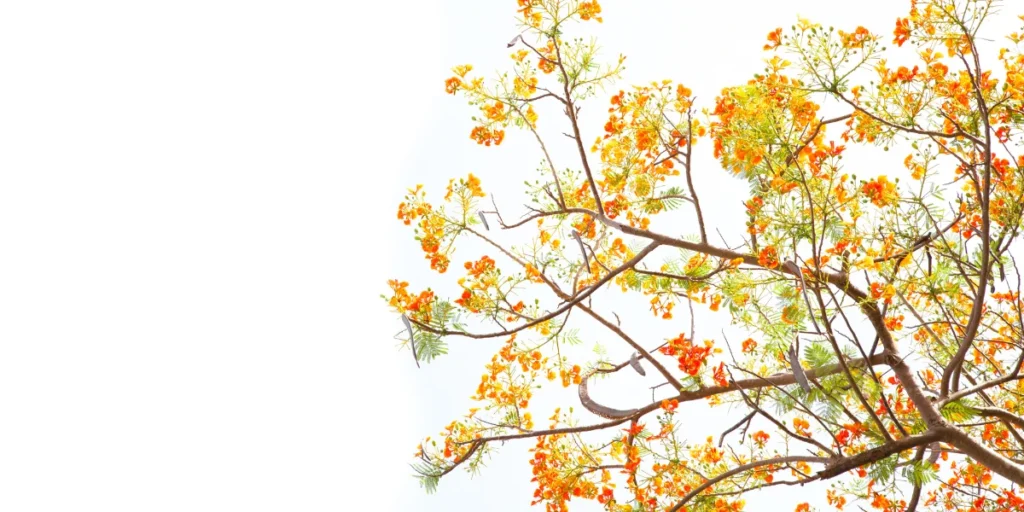
Establishing peacock flower plants in your garden takes some preparation and care. Follow these steps for successful planting.
When to Plant
The ideal planting time is at the start of the growing season after the last spring frost date. Plant in late spring to early summer to allow new plants the entire season to establish roots before cold conditions arrive.
Propagation from Seeds
Growing peacock flowers from seeds is a simple propagation method. Start seeds 8-12 weeks indoors prior to the last expected frost.
Sow seeds just below the soil surface. Provide warm temperatures around 70-80°F until germination, which takes 14-21 days. Slowly introduce outdoor conditions over 2 weeks before transplanting seedlings outdoors post-frost.
Transplanting Seedlings or Potted Plants
Dig holes slightly wider and deeper than the root ball of potted seedlings or plants. Gently loosen root bound specimens. Partially backfill and water thoroughly to settle the soil before mulching around transplants. Space plants 4-6 feet apart.
Check out How to Grow Kurinji here
Care and Maintenance
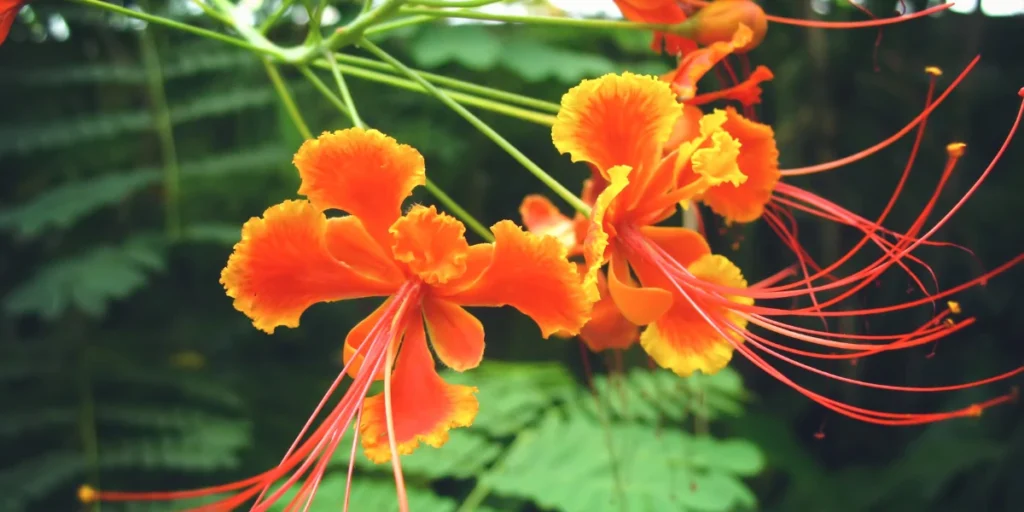
Proper care measures are necessary for robust plant health and abundant flowering each year.
Watering
Peacock flowers require regular irrigation for best performance. Water plants thoroughly 1-2 times per week in the absence of rainfall, allowing soil to partially dry between waterings. Frequency can vary based on plant size, container versus in-ground growing, and climate conditions.
Avoid waterlogged soil and periods of prolonged drought for healthiest growth. Drip irrigation systems provide consistent moisture during heat spells.
Fertilizing
Use a balanced slow-release fertilizer or rich compost to maintain soil fertility. Fertilize at full strength in spring and half strength monthly through summer and fall. Discontinue feeding after September.
Pruning
Prune peacock flower shrubs in late winter or very early spring before new growth begins. Remove up to one-third of old branches or dead wood at the base to shape plants. This improves air circulation and encourages prolific blooming on vigorous new wood.
Pests and Diseases
Caesalpinia pulcherrima has few serious pest or disease issues. Common potential problems include spider mites, leaf spot fungus, root rot from overwatering, and sooty mold. Maintain plant health and sanitation practices to avoid infections. Apply appropriate organic treatments if issues occur.
Check Out How to Grow Gmelina Arborea? here
Uses in Landscaping

The tropical flair of Caesalpinia pulcherrima brings exciting visual interest to gardens and makes an excellent landscape plant for creating focal points.
As Specimen Plant
The flowers and form of single peacock plants can anchor corners of beds or small island plantings for striking solo impact. Allow adequate space to showcase their seasonal display.
In Borders and Beds
Position peacock flower shrubs in mixed borders and beds near shorter plants to highlight the vibrant bloom colors against surrounding greenery. Combine with blue or purple flowering companions. Repeat in mass plantings for security and drama.
Container Planting
Grow peacock flowers alone or with thrillers and fillers in large planters on patios, poolside, and other high-visibility areas to bring upward mobility and tropical punch. Ensure containers provide adequate root space, drainage, and nutrients.
Read More About How to Grow Jai Jui Flower here
Additional Tips
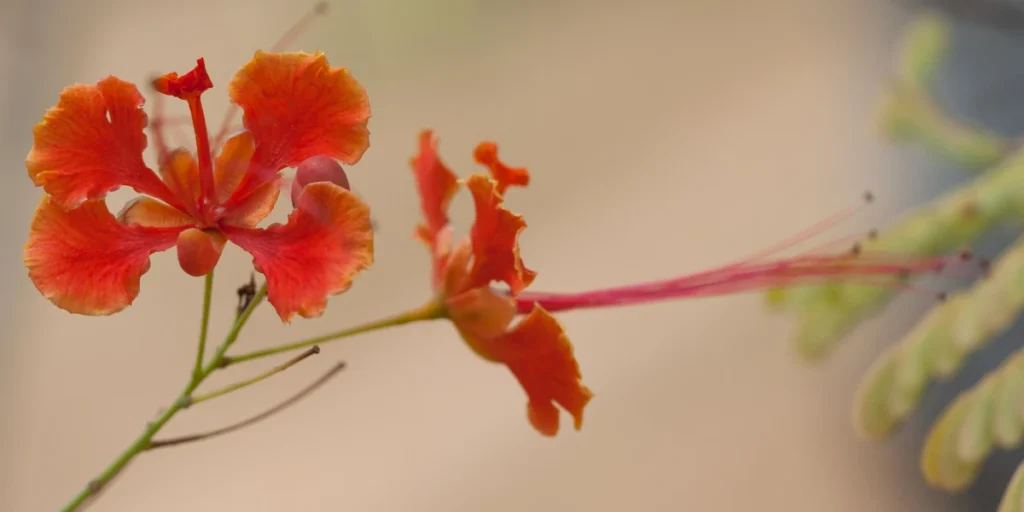
Overwintering
Peacock flowers grow as annuals in zones below 8b where winter lows fall below 15-20°F. However, potted plants can be overwintered indoors in colder climates until temperatures allow replanting outdoors the following season.
Before first frost, prune plants back by one-third, move containers to a sunny indoor location with 60-65°F temperatures, and reduce watering until spring growth resumes. Repeat this process annually.
Propagation from Cuttings
Take 6-8 inch tip cuttings from healthy branches. Dip cut end in rooting hormone and insert in perlite/peat propagation mix. Maintain warmth and humidity with gentle air circulation until roots form in 3-4 weeks. Transplant rooted cuttings outdoors after hardening off.
Read About How to Grow Anthurium Magnificum here
Conclusion
Caesalpinia pulcherrima delivers vivid, tropical beauty as a flowering shrub for gardens and landscapes. By understanding its growing requirements and providing good care with ample sunlight, warm temperatures, well-drained soil, and sufficient watering, peacock flowers will thrive and impress as colorful floral accents.
Frequently Asked Questions
What are peacock flowers best for?
Peacock flowers are prized showy features for tropical gardens, mixed borders, planter boxes, pool landscaping, and more. They create focal points with vibrant color and exotic, lush foliage.
What colors do peacock flower blooms come in?
Peacock flowers produce blooms in stunning shades of yellow, orange, red, pink, peach, and bicolored combinations. Some popular varieties to try are ‘Nana’ (dwarf yellow), ‘Tall Apricot’ (apricot blooms), and ‘Red Bird of Paradise’ (vibrant red).
How often do you need to water peacock flower plants?
Ideally, water peacock flowers 1-2 times per week during the growing season for optimal plant health and flowering performance. Increase frequency during periods of drought and extreme summer heat. Soil should be moist but not saturated between irrigations.
Can you grow peacock flowers in containers?
Yes, container planting is an excellent way to grow peacock flowers. Use large planters at least 12-24 inches wide and deep to accommodate their bushy growth habit. Ensure containers have adequate drainage through holes at the base. Maintain consistent soil moisture and fertilize regularly with a complete liquid plant food during the growing months. Move containers to sheltered areas for winter protection in cooler zones.
How do you overwinter potted peacock flower plants indoors?
To overwinter containerized plants, cut stems back by one-third in late fall, then bring pots inside before temperatures drop below 45°F, ideally to a bright room around 60-65°F. Water minimally, just enough to prevent leaf drop. Store dormant plants in a cool, dark location for winter until warming spring weather allows moving them back outside. Resume normal care when new growth appears.
Do peacock flowers come back every year?
Yes, in ideal climates (Zones 9-11), peacock flowers will return each year as evergreen flowering shrubs if they remain undamaged by winter cold. In zones 8 and below, they can be grown as annuals, or containers with established plants can be overwintered indoors until summer. Provide good care and prune old wood in late winter to ensure prolific reblooming.
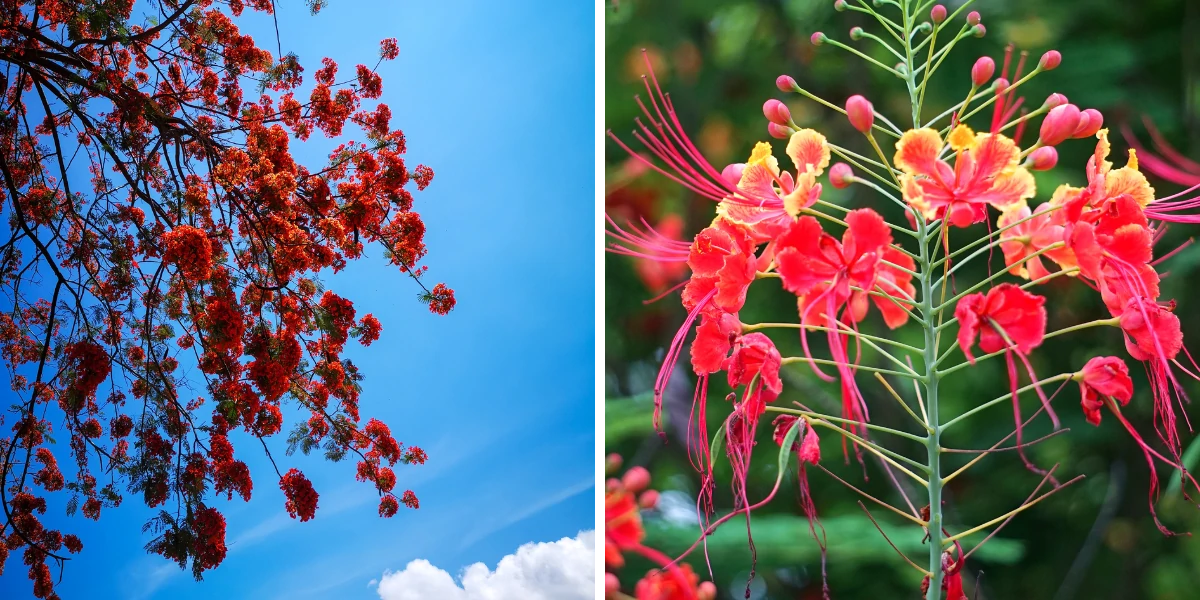
1 thought on “How to Grow Caesalpinia pulcherrima | Peacock Flower Care”